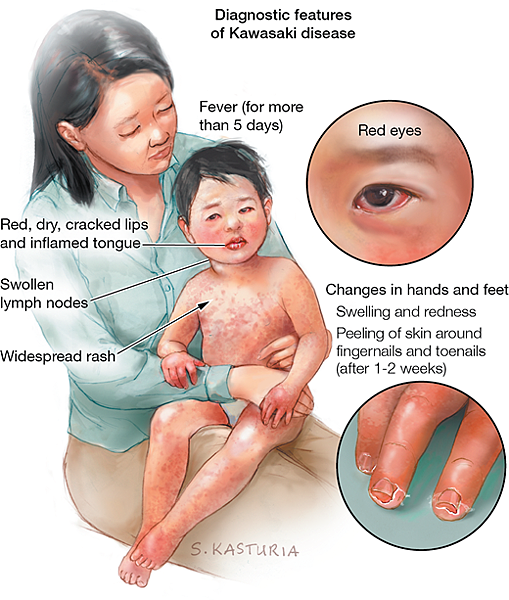
Kawasaki disease is a type of vasculitis (inflammation of the blood vessels) that can affect many organs. Its cause is unknown, but symptoms usually start with fevers as high as 105.8°F in children younger than 5 years.
It occurs most often in children of Japanese origin. Kawasaki disease can result in coronary aneurysm (an outpouching in the wall of the blood vessels that supply the heart muscle). This is the most serious complication.
DIAGNOSIS
No tests definitively diagnose Kawasaki disease, so physicians have to evaluate whether children meet certain criteria. They must have had a fever for 5 or more days as well as any 4 of the following:
- The whites of both eyes appear red, with no discharge or a clear discharge from the eyes
- Dry, cracked lips; inflamed tongue and throat
- Swelling of the hands and feet and desquamation (peeling of the skin), especially near the fingernails, toenails, and diaper area
- A red rash that can be widespread (usually not on the face)
- Swollen lymph nodes, most often on one side of the neck
Infants younger than 6 months and older than 5 years may not have all the required symptoms and may be diagnosed as having atypical Kawasaki disease.
EVALUATION
In addition to physical examination, a doctor may order
- Blood tests to look for increased number of white blood cells (infection-fighting cells), increased number of platelets (cells that form clots), or high levels of substances that indicate inflammation; urinalysis to look for increased number of white blood cells with no other signs of urinary tract infection
- An echocardiogram (an ultrasound of the heart) to check for coronary aneurysms and heart muscle involvement
TREATMENT
- Intravenous immunoglobulin (IVIG) is a product derived from human blood that is made of antibodies that fight infection and inflammation. Treatment is given in the hospital intravenously(through a vein).
- High doses of aspirin may be given, followed by a course of low-dose aspirin after the fever resolves. The length of treatment depends on whether coronary aneurysms are found.
- In severe cases not responsive to IVIG, corticosteroids (medications used to reduce inflammation) or other anti-inflammatory medications may be used.
FOLLOW-UP
Children need close follow-up once they are discharged from the hospital.
- Cardiologists will order echocardiograms at regular intervals to look for coronary aneurysms and decide the length of treatment with aspirin.
- IVIG can interfere with vaccines, especially the MMR (measles-mumps-rubella) and varicella(chickenpox) vaccines. It may be recommended to withhold vaccines for 11 months following IVIG.
- Because aspirin can have serious effects in children who get chickenpox or influenza, parents must notify their physician immediately if they are exposed to influenza or varicella or have any symptoms.





 留言列表
留言列表
 線上藥物查詢
線上藥物查詢 